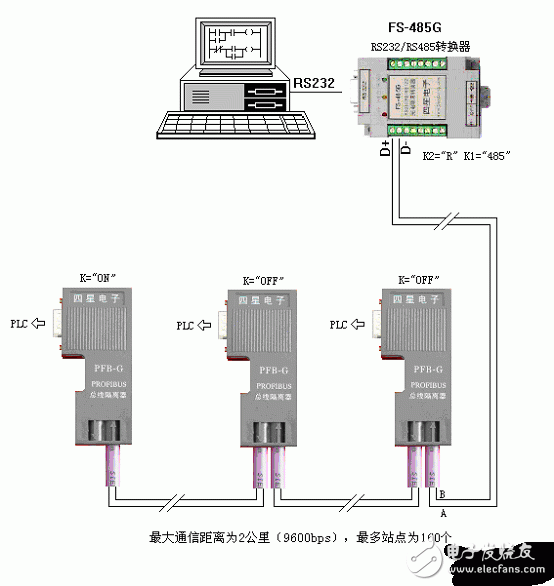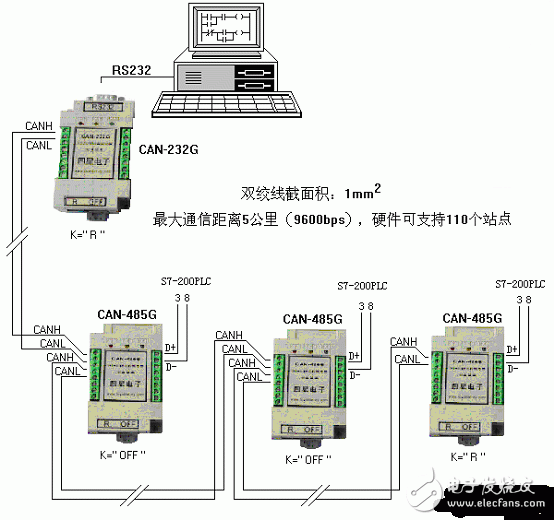The RS485 communication network consisting of Siemens S7-200PLC has a maximum communication distance of 500 meters and can be connected to 32 nodes. When the distance exceeds 500 meters, RS485 repeater needs to be installed on the RS485 bus. For convenient wiring, each PLC A bus connector is required for the communication port, and terminal resistors are required at both ends of the network. This is a conventional communication scheme with several disadvantages: 1. When the distance exceeds 500 meters, RS485 repeater needs to be added to extend the communication distance, and the repeater needs to supply power. This will cause great trouble for some unpowered conditions, such as field, oil field and seabed. 2. The entire communication network is non-isolated, and the anti-interference ability is poor. Especially when the inverter is connected to the network, it is easy to cause error and crash. 3. Since the communication network is non-isolated, when there is lightning or other strong transient voltage interference acting on the network, it will inevitably cause damage to all PLCs on the network, causing significant losses! The use of Deyang Four Star Electronics to develop PFB-G bus isolator or CAN-485G remote drive can solve the above problems: First, use PFB-G isolator to reach 2 km communication distance: By installing the PFB-G bus isolator in the communication port of each PLC, as shown in the figure below, the maximum communication distance can be 2 km (9600 bps) without repeater, and the maximum number of stations is 160, if the distance exceeds 2 Km can be installed in the network RS485 repeater (model: E485GP), PFB-G's maximum communication rate is 12Mbps, can be used for PROFIBUS network, PPI network, MPI network and free port communication network and other RS485 network, especially suitable for The harsh environment with large interference, because the photoelectric isolation solves the problem that the nodes often damage the communication port due to the ground potential difference, and minimizes the interference in the communication, especially when there is a frequency converter communication in the network. More obvious. For example, the inverter needs to be connected to the inverter for communication. For the convenience of installation and wiring, the PFB-G can be replaced with a BH-485G isolator, and the RS485 port of the inverter is isolated by the BH-485G and then connected to the bus. Very good solution to the interference and crashes when the PLC communicates with the inverter! Second, use CAN-485G remote drive to reach 5 km communication distance: By installing the CAN-485G remote driver at the communication port of each PLC, as shown in the figure below, the maximum communication distance can be 5 km (9600 bps) without repeater, which may be the current copper transmission without repeater. The maximum distance, CAN-485G is an isolated transparent transmission driver. This product does not use the CAN protocol and uses a transparent transmission method. Therefore, it is not necessary to make any modifications to the original software after using CAN-485G! CAN signals have many advantages compared to RS485 signals. Readers can refer to related articles on the website. Description: The cross-sectional area of ​​the communication line is larger than that of the RS485 communication line. The twisted pair of 1mm2 should be selected. Since CAN-485G and CAN-232G (RS232 port connected to the computer) are designed with two pairs of bus terminals, the wiring as shown in the figure does not exist. The branch line problem is gone. The CAN-485G and CAN-232G have been designed with a terminating resistor inside. The terminal resistance setting switch K on the beginning and end of the bus needs to be set to “R†(access to 120 ohm terminating resistor), while other stations should be set to “OFFâ€. "(Do not connect the terminating resistor). If the inverter needs to be connected to the inverter, please connect the RS485 port of the inverter to the bus after being isolated by CAN-485G. This solution can solve the interference and crash when the PLC communicates with the inverter. Both CAN-232G and CAN-485G require 5VDC working power. For CAN-232G, the working power can be taken from the USB port of the computer or regulated by 5VDC. The working power of CAN-485G must be supplied separately by the 5VDC regulated power supply. The 5VDC power supply output from the 6th and 5th pins of the Siemens S7-200PLC communication port cannot be used as a power supply because of a series connection of 100 ohms. The above scheme has been proved to be very stable and reliable in actual engineering. In fact, it is suitable for any other equipment that uses RS485 communication. Even if it is close-range communication, it can be completed without isolation driver, but the isolated network is very Stable and reliable, the equipment failure will be greatly reduced, such a small investment will certainly gain a lot of benefits. Ningbo Autrends International Trade Co.,Ltd. , https://www.mosvapor.com
